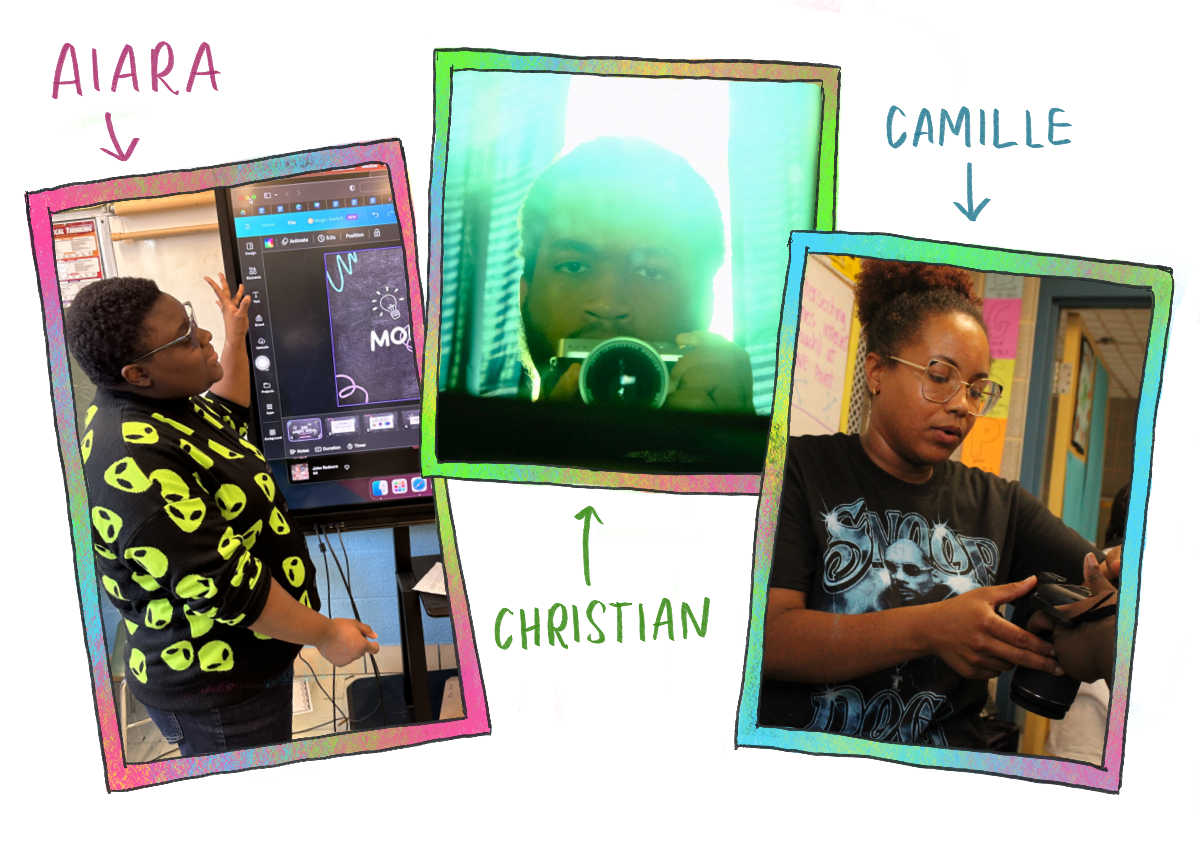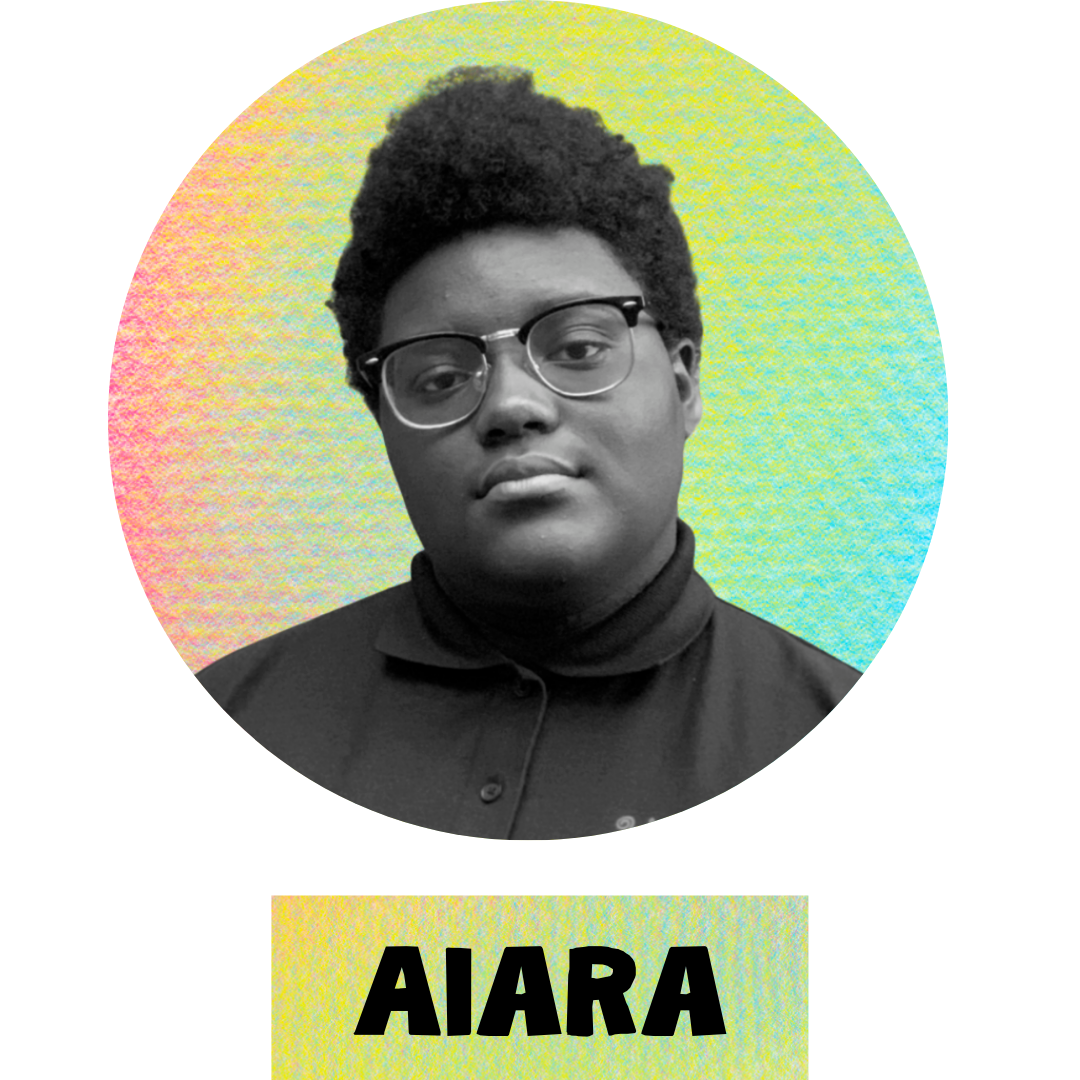DREAM BIG 2023
This winter, we’re shining a spotlight on our younger students through our Dream Big campaign to support 90 middle school students in our Baltimore Speaks Out (BSO) program. We’re hitting rewind with three staff members to learn how they discovered media making, why it’s been so formative for them and how those experiences shape their approach to working with our youngest learners.
Get to know three of our BSO instructors - Aiara Manning (Arts2Work Apprentice - Junior Designer & Assistant Media Educator), Christian Lewis (Media Instructor), and Camille Ollivierre (Media Instructor) as they take a walk down memory lane.
Middle school Aiara was a huge nerd. That was the basis of most of my personality. I had just transitioned to living in the city (from the county), where I had done my first year of middle school. At the time, I didn’t have a connection to visual arts. Honestly, Wide Angle was a big part of me seeing creativity as an outlet. Within 3 weeks of joining as a high schooler, I was making work that represented me as a person. A big part of design bridged the gap between my tech brain and the art brain I wanted.
High school was me getting into the arts, but by the time I got into college, it was still a backburner thing. I was a computer science major. I didn’t see myself doing art for a living. A year into college, I realized I didn’t want to do that as a job for the rest of my life. I had no idea what path I wanted to take after that. I took a gap year from college and none of the jobs I was applying for really fit me. Then, Wide Angle reached back out with an opportunity to work as a Design Intern in their workforce pathway. Now, I am a state-registered Design Apprentice and I also teach in the BSO middle school program, where, coincidentally, I teach students at Mount Royal (my middle school!).
Telling a story is an act of play. Middle schoolers get no chances to guide themselves through their learning - it’s all structured in specific time blocks. Most middle schoolers don’t learn like that. They are whip-crack sharp. Recently we did vector portraits in Figma. It’s taken me months of trial and error, and error, and error, to learn the basics. I taught them the pen tool, and in one day they had it down. I am a designer, and I do this every day, and it’s still a challenge for me to learn the program. But, they had it immediately and on an independent level.
Teaching at Mount Royal is almost like I’m going back in time and nurturing my past self. I didn’t get these opportunities when I went to this middle school. So, I’m going to try my hardest to bring those opportunities to the middle schoolers there now. Art is really important for development. Beyond what I’ve experienced, I’ve seen what it can do for students. I’ve had past students come back or reach out and tell me this program changed their lives. I wish someone could have done that for me.
At a younger age, I wanted to be a comic book artist. That was the earliest form of storytelling I was into. Before I was into video, I wanted to be a cartoonist. Middle school me was grounded but still kind of on another planet, too. I was mainly in the visual arts, mainly illustration. I could be free to be whatever I wanted, to create my own language. And that’s the way that the arts helped me to express myself - not having to make sense and being in my own space or creating my own spaces.
In high school, I was on Baltimore City College’s debate team, which is nationally regarded. Being in debate allowed me to have a deeper understanding of revolutionary politics and gave me access to great critical thinkers. That space made me want to understand myself more and how I interacted with everything, and that’s something I wanted to incorporate into my art.
I was also heavily into film classes in high school. It made me realize how much I loved storytelling. At the same time, I had friends who were using digital/audio workstations. A friend of mine gave me a copy of FL Studio. From that point on film and music essentially became all I wanted to do and it was all I did. That’s how it’s been since - that still persists now. I majored in cinema and minored in music at McDaniel College.
Film should be collaborative and it should be a human and thoughtful process. Egoism should have nothing to do with it. Engaging with students, I want to help funnel their energy. Trying to get them to develop the skill to inject that energy into what they’re working on - that’s really fun with students as they develop their artistic language. Being very hands-on and providing encouragement is key for me and how I engage with them. Ensuring it’s a positive and comfortable space for everyone.
Middle schoolers are very early in their own story. Working on art or storytelling concepts can help provide context to certain things they’re going through or how they interact with the world. It helps them build awareness and empathy. Storytelling is innately empathetic.
Middle school Camille was a very quiet art kid, but also smart. I was also a band kid. I had a scowl most of the time at school - it was my ‘mask’ for facing the world and not showing vulnerability. But, I loved getting any kind of art supplies and doodling. Art class was where I shined because I drew a lot in my spare time. That was my biggest flex - my ability to draw. If there were bubble letters involved, it was like, “let Camille draw them out”. Any group project with an art or drawing aspect, people wanted me on their team. Since I didn’t speak much to my peers, I would show them my awesome notebook cover designs. I leaned into using my creativity as a way to start conversations. I was a quintessentially awkward band, art, nerd kid.
I was in a medicine magnet program in the engineering pathway at Glen Bernie High School. At one point, I wanted to be a medical illustrator. We could only take a limited number of electives. I chose art classes and went really hard for the 2-3 I could take, to offset my required math and science classes. I also loved video games and wanted to do video game design, and that’s why I went to college at UMBC. I decided to study gaming because that felt like a way I could be a girl in STEM, combine my passions, and still have some creative outlet. At UMBC, I took 2 years of computer science classes but it just wasn’t working.
One day, I changed to visual arts with a concentration in animation, and it was freeing. It was the best decision I made in college - I was drawing every day and being exposed to different types of animation. I had professors who talked about balancing teaching and having really interesting themes drive your personal work. They showed me that there are always options to continue to grow as an artist.
For middle schoolers, especially for art, it’s important for them to have a level of choice. Often in art classes in school, you learn about past artists and how to replicate their style, not here’s the technology you have access to, here’s your materials, and here’s the challenge I have for you. That setup can lead to really deep work and a level of expression that is more freeform than the standard classroom.
Middle school is a time of a lot of change and figuring out a lot about yourself, and it can be brushed over in the day-to-day shuffle. Art can be that outlet that lets them come out of their shell. I’ve seen my students grow in how they interact with each other and how they work on a project together. They are so tech-savvy, I can show them once, and in 40 mins, they’ve created a masterpiece. They’re enthusiastic to just dive in and that is such an important skill to use as an artist.
Baltimore Speaks Out connects to so many themes Aiara, Christian, and Camille have touched upon. As youth practice media literacy and develop projects, they are learning life-long skills and for some, cultivating a life-long passion.
Your gift today is an investment in the passions and creativity our students will take with them well into the future, as they continue on their own artistic and professional journeys.
MEET THE AUTHOR
Moira discovered her interest for visual art in middle school, and cultivated that passion in high school and college (where she studied painting and photography). She moved to Maryland to pursue her Masters in Community Arts at Maryland Institute College of Art in 2008 and spent five years working with BCCC’s Refugee Youth Project to support the social and emotional integration of refugees. She has over fifteen years of experience in creative youth development and has worked with communities in Baltimore, as well as in Honduras, Nicaragua, Vietnam, England and India. In Fall 2013, she joined Wide Angle as the Youth Photography Traveling Exhibition Coordinator. In 2015, Moira took on the Program Director role and in 2018 she transitioned to the Development and Communications Director.












